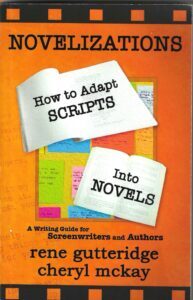Gutteridge and McKay Turn Scripts into Novels

Rene Gutteridge and Cheryl McKay. 2014. Novelizations: How to Adapt Scripts into Novels. USA: Purple Penworks.
Review by Stephen W. Hiemstra
The idea of adapting a novel from a script sounds like using turning a concert tour into a book. Sure, you can do that, but why? Doesn’t the process usually work the other way around?
Introduction
Rene Gutteridge and Cheryl McKay in their book, Novelizations: How to Adapt Scripts into Novels, write: “Hollywood loves to know they have a built-in audience with whom to start.” (11) The motivation for novelization is simple: It is good marketing. Even scripts that have been produced can get canceled because of the high costs of marketing and distribution. Having a book that already has a large audience is a large plus in assuring that a film project goes forward.
Streaming television shows have to demonstrate that they have an audience of at least ten million to be renewed. Because novelists seldom achieve such an audience, what remains a mystery is how a typical novel could ever make such a contribution. What we learn towards the end of the book is that screenwriters need to partner with established authors in order to meet their audience objective of getting bragging rights from a novelization project. (161)
If the motivation for a novelization project is obvious, how does it actually get done? The objective of this book is to walk the reader through the process of converting a script into a novel. Story, structure, characters, dialogue, and voices require little adjustment, while point of view characters, backstory, interior monologue, and details about setting are areas where changes and additions are needed. (16)
Background and Organization
Rene Gutteridge is a novelist and graduate of Oklahoma City University. Cheryl McKay is a screenwriter and holds a masters from Regent University.
Gutteridge and McKay write in ten chapters:
Overview
Changes & Challenges
Setting
Point of View
Structure & Plot
Interior Monologue
Backstory
Characters
Dialogue & Voices
Partnership (vii)
These chapters are followed with acknowledgments and an about page.
Setting
Screenwriters, unlike novelists, typically work in teams. In the case of settings, whole departments contribute to the scene settings: “The camera department, the production designer, crewmembers who work in locations, art direction, set building, props, wardrobe.” (39) Screenwriters can work painting with broad strokes upfront in a scene to establish the setting where a novelist may need to research and describe every little detail sprinkled throughout a chapter (43).
Point of View
While a script can introduce a quick survey of a character’s life with a montage of visual snippets or display an entire landscape with a drone camera, the same survey in a novel must travel through someone’s head. Point of view requires an observer that may be absent in a script.
Gutteridge makes an interesting observation: “It’s not that he just sees the rocker, but how does he see the rocker? What does he feel when he sees it?” (62) The character in a novel ideally is not a passive observer, but interprets the objects seen. Was the character rocked as a child in the rocker or was a parent shot to death in it?
Structure and Plot
A script typically establishes a scene in location, time, and person. Change any of these and you have a new scene, which makes transitions clear. Consequently, a script may have a lot of short scenes.
Short scenes in a novel are rare. A novel can incorporate such transitions within a given scene or chapter which may lead to sloppy transitions or, depending on the writer, handle such changes seamlessly. (75)
Interior Monologue
A script may need to have a separate scene to reveal backstory and flashbacks, which may easily be handled in a novel with interior monologue. (76) Screenwriters cannot normally employ interior monologue because it cannot be seen and heard on the page (89), which implies that novelizations need to pen that into the novel. (89) These interior moments need to create conflict, add mystery, advance the plot, reveal motives, or do something else worthwhile given the caveat that interior monologue is telling, not showing—typically a no-no in novel composition. (93-94)
Backstory
In a screenplay, backstory is often cloaked in emotion or some action, not straight up exposition in dialogue, guidance equally good for novel writing. (110) Interior monologue can also be used, as mentioned earlier. Either way, it should advance the plot. (111)
Characters and Dialogue
Characters and dialogue cost money in a screenplay production, but come cheap in novels. This implies that screenplays are parsimonious in both and need to be added during a novelization. Characters added to a novel often require backstory. Dialogue may include subtext that requires explanation in the novel, something handled by actors in a screenplay. The world of the screenplay may need to be fleshed out in the novel, particularly in dialogue. (149)
Assessment
Rene Gutteridge and Cheryl McKay’s Novelizations: How to Adapt Scripts into Novels is a surprisingly helpful book, even if you never novelize a screenplay. Of course, if you plan to novelize your screenplay, start with this book.
Early in your screenwriting career, the difference between a novel and a screenplay may seem fuzzy, little more than an exercise in abbreviation and reformatting in a screenwriting software package. Gutteridge and McKay help mark the boundaries between the two media—especially in their novelization examples—so that the strengths and weaknesses of each become clear. This book is consequently of greatest value to young screenwriters and any novelist attempting to adapt their work for film.
Gutteridge and McKay Turn Scripts into Novels
Also see:
Cahir Dissects Film Adaptation
Seger Adapts Stories into Film
Other ways to engage online:
Author site: http://www.StephenWHiemstra.net
Publisher site: http://www.T2Pneuma.com
Newsletter at: https://bit.ly/Janu_25, Signup
The post Gutteridge and McKay Turn Scripts into Novels appeared first on T2Pneuma.net.



